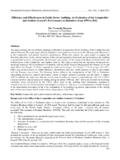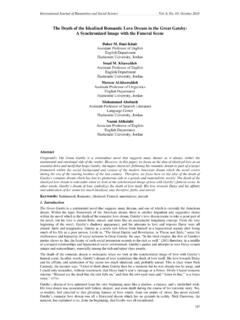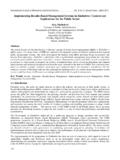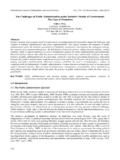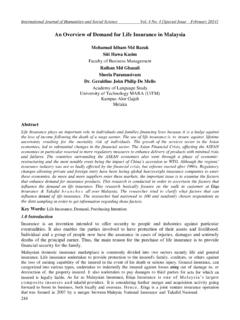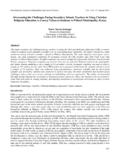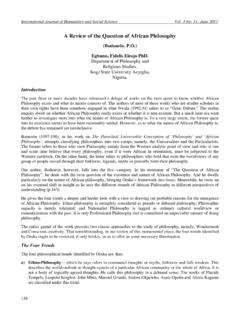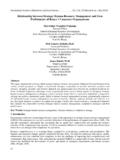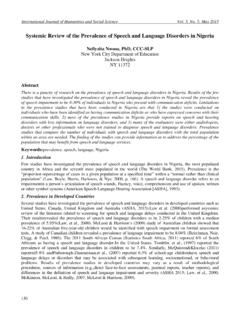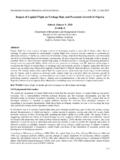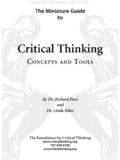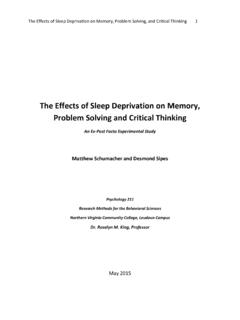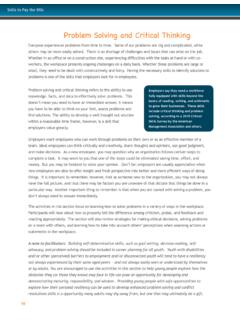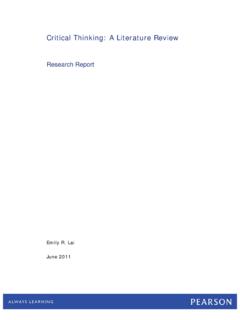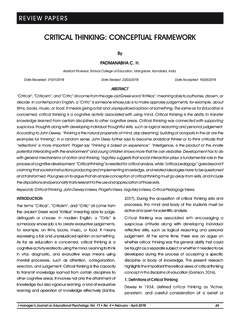Transcription of Critical Thinking in Nursing Process and Education
1 International Journal of Humanities and Social Science Vol. 1 No. 13 [Special Issue September 2011] 257 Critical Thinking in Nursing Process and Education Belgin YILDIRIM PhD, RN, Research assistant Ayd n School of Health Adnan Menderes University Ayd n, Turkey kran ZKAHRAMAN PhD RN, Assistant Professor Faculty of Health Science, S leyman Demirel University Isparta, Turkey ABSTRACT Critical Thinking is the Process of searching, obtaining, evaluating, analyzing, synthesizing and conceptualizing information as a guide for developing one s Thinking with self-awareness, and the ability to use this information by adding creativity and taking risks. The Nursing Process has been important to Nursing practice for a long time. The Nursing Process has been used as a problem - solving activity to think about a plan of care as the foundation for professional practice in everyday Nursing practice. The Nursing Process may describe a Nursing care plan that provides students with a learning experience that helps them practice Critical Thinking and decision making skills.
2 The Nursing Process is seen as a decision making approach that promotes Critical Thinking in Nursing . This Process consists of five phases namely: assessment, diagnosis, planning, implementation and evaluation. Key Words: Critical Thinking , Nursing Process , Critical Thinking in Nursing Process Critical Thinking There is no universally accepted definition of Critical Thinking ; however the Delphi report published by the American Philosophical Association gave us a description of Critical Thinking in terms of cognitive skills and affective dispositions that was generic with no domain-specific implications. This resulted in a definition of Critical Thinking "as the Process of purposeful, self-regulatory judgment; an interactive, reflective, reasoning Process " (Facione 1990). The Delphi report described the ideal Critical thinker as one who is habitually inquisitive, well-informed, trustful of reason, open-minded, flexible, fair-minded in evaluation, honest in facing personal biases, prudent in making judgments, willing to reconsider, clear about issues, orderly in complex matters, diligent in seeking relevant information, reasonable in the selection of criteria, focused in inquiry, and persistent in seeking results which are as precise as the subject and the circumstances of inquiry permit.
3 Critical Thinking in the Profession of Nursing The Delphi definitions are consistent with and supportive of Kataoka-Yahiro and Saylor's (1994) definition of Critical Thinking in Nursing as "the Critical Thinking Process is reflective and reasonable Thinking about Nursing problems without a single solution and is focused on deciding what to believe and do". This definition broadens the concept of Critical Thinking in Nursing to include reflection of thoughts and recognition that there can be various solutions to problems. The Nursing Process is a scientific- problem solving model using the steps of assessment, Nursing diagnosis or problem identification, planning, implementation, and evaluation in a step-by-step Process to plan care for patients. Critical Thinking in Nursing has long been equated with the Nursing Process which confines Critical Thinking to a very linear, narrow, single right solution, problem - solving Process .
4 Critical Thinking includes creative Thinking , open-mindedness, inquisitiveness, and is not bounded by predefined standards and objectives. Critical Thinking does include knowledge, skills, and attitudes, and it definitely incorporates the important component of the Nursing Process and problem - solving approach, but it goes beyond to higher-order Thinking and is not a synonymous term with " Nursing Process ." Critical Thinking is not a single way of Thinking , but is a complex, multidimensional cognitive Process dependent on reflective thought and tolerance for ambiguity essential for decision making in Nursing practice (Jones, Brown 1991). Nurses are challenged to "think on their feet" in the multiple, complex, fast-moving environments of today's Nursing practice. The literature repeatedly stresses that nurse must be able to think critically in order to Process complex data and make sound clinical judgments in the planning, managing and evaluating of the health care of their patients (Raines 1996).
5 The Special Issue on Social Science Research Centre for Promoting Ideas, USA 258 The practice of Nursing requires "creative, personalized solutions to unpredictable client circumstances'' (Miller, Malcolm 1990). According to Facione and Facione (1996), Nursing practice demands fair-mindedness to new evidence and a willingness to reconsider clinical judgments. It values a focused and diligent approach to ill-structured patient problems, and requires tolerance of multiple perspectives and interpretations when such perspective and interpretations can be supported by reasons and evidence. While the Nursing Process demands linear Thinking to problem solve, Critical Thinking abilities compel nu ses to challenge assumptions, question the context, look for new ways of doing and Thinking , and consider, sift, and evaluate ideas or solutions for their worth and practicality (Bumard 1989).
6 These abilities are essential for making sound clinical judgments in order to provide safe, effective care to patients. Kataoka-Yahiro and Saylor (1994) feel that to make good Nursing judgments, Critical Thinking must be used. They have identified five components of Critical Thinking : (1) specific Nursing -based knowledge, (2) practical experience, (3) Critical Thinking competencies, (4) attitude or Paul's "traits of the mind," and (5) standards (intellectual and professional). Component number 3, Critical Thinking competencies, is divided into three cognitive types: general, specific in clinical situations, and specific in Nursing . General Critical Thinking competencies are not unique to Nursing but include scientific Process , hypothesis generation, problem solving , and decision making. The specific Critical Thinking competencies in clinical situations, including diagnostic reasoning, clinical inferences, and clinical decision making, are used in Nursing and other clinical disciplines.
7 Finally, the specific Critical Thinking competency in Nursing is the Nursing Process but it is only one of the competencies and not all-encompassing. The attitude component is considered a central aspect of a Critical thinker and includes confidence, independence, integrity, risk taking, creativity, and fairness. The fifth component, standards, includes universal intellectual standards such as clarity, specificity, accuracy, relevancy, and significance as well as professional standards such as ethical criteria for Nursing judgments and criteria for evaluation and professional responsibility. The authors also feel there are levels of Critical Thinking in Nursing and have identified them as basic, complex, and commitment. The basic level is an early step and looks for right or wrong or one right answer to complex problems. Realizing that there are alternative solutions moves the nurse to the complex level, and choosing an action or belief based on an alternative puts the nurse at the highest level of commitment.
8 Education needs to provide a learning environment that is conducive to Critical Thinking , giving the students opportunity for flexibility, creativity, support for change, and risk taking. According to Y ld r m (2011), Critical Thinking is the Process of searching, obtaining, evaluating, analyzing, synthesizing and conceptualizing information as a guide for developing one s Thinking with self-awareness, and the ability to use this information by adding creativity and taking risks . Critical Thinking IN Nursing Process One technique for understanding a concept with an unclear definition in Nursing is to review the literature for examples. When looking for examples of Critical Thinking , descriptions of Nursing Process were found. This is incongruent with the treatment in the Nursing literature of Critical Thinking as an outcome. Nursing Process , while it has been given many different meanings is generally described as a linear Process using the four steps of assessment, planning, intervention, and evaluation (Y ld r m 2010b).
9 Nursing Process is a problem - oriented model that breaks down symptoms into Nursing problems utilizing Nursing diagnosis. The format is logistic with a series of discrete components in unvaried sequence and inflexible. Nursing Process is congruent with the perspective of measuring outcomes by benchmarking and prototyping and is useful because it encourages uniformity in practice. The focus is on looking for similarities between the patient and the expected benchmark for that day. Stevens-Barnum (1994) notes that when comparing Nursing Process to holistic methods, they are at opposite ends of the spectrum with regard to principle, method, and interpretation. This is a concern for those with a holistic perspective. Abdellah (1969) is credited with initializing the essence of Nursing Process with her twenty-one Nursing problems typology. Her goal was to develop a strong knowledge base for nurses and promote autonomy.
10 It was to be a guide for identifying and solving patient problems. The problem was defined as a condition faced by the patient and family, which the nurse can help with through her professional functions. There is consistency even in this initial attempt at typology due to her labeling of the problems as Nursing problems and not patient problems. Abdellah's (1969) assertion is that patients cannot receive adequate care without first addressing patient care with a focus on ' problem '. International Journal of Humanities and Social Science Vol. 1 No. 13 [Special Issue September 2011] 259 The focus on the problem hence illness aspect of the patient is a weakness that Abdellah (Abdellah, Levine 1986) acknowledges herself. Flaws within Nursing Process have been documented by Benner (1984) in her work within the development of her Novice to Expert model. Her work revealed that those nurses with little experience used Nursing Process better than those who were expert.
